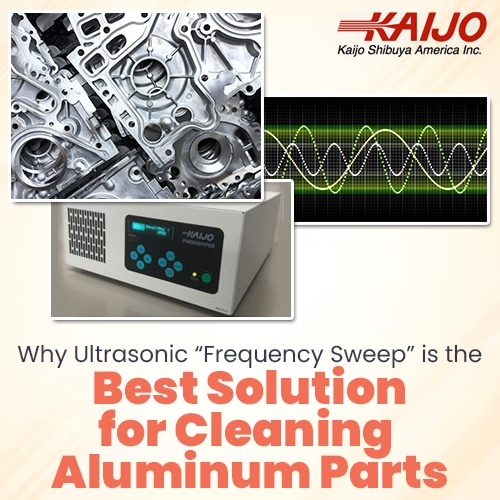Why Ultrasonic ‘Frequency Sweep’ Is the Best Solution for Cleaning Aluminum Parts
June 20, 2023
A luminum parts are often difficult to clean quickly and completely because the metal is comparatively soft and aluminum is chemically reactive. Traditional cleaning methods, such as brushing and scraping, can damage the soft surface of aluminum parts. Soaking can dissolve some of the aluminum if the soaking solution contains chemicals that react with aluminum. Switching to ultrasonic cleaning avoids these problems. Ultrasonic systems can rapidly remove all surface contamination without damaging the parts to be cleaned.
luminum parts are often difficult to clean quickly and completely because the metal is comparatively soft and aluminum is chemically reactive. Traditional cleaning methods, such as brushing and scraping, can damage the soft surface of aluminum parts. Soaking can dissolve some of the aluminum if the soaking solution contains chemicals that react with aluminum. Switching to ultrasonic cleaning avoids these problems. Ultrasonic systems can rapidly remove all surface contamination without damaging the parts to be cleaned.
Ultrasonic cleaners work with one operating frequency corresponding to the nature of the contamination and the composition of the parts being cleaned. When the ultrasonic system incorporates an ultrasonic generator with a frequency sweep feature, fast and even cleaning is ensured in all parts of the cleaning tank. An ultrasonic cleaner using the right frequency and frequency sweep can deliver unparalleled cleaning performance and represents the ideal solution for cleaning all kinds of aluminum parts.
Understanding How Ultrasonic Cleaning Works
Ultrasonic cleaning works by generating ultrasonic sound waves in the cleaning solution. Ultrasonic generators produce a high-frequency signal that is transmitted to transducers in the cleaning tank. The transducers convert the electric signal to ultrasonic waves that travel through the cleaning solution. Microscopic cavitation bubbles form in the low-pressure troughs of the waves and burst in the high-pressure peaks. When they burst, the bubbles release tiny but energetic jets of cleaning solution that strike the surfaces of the parts to be cleaned and dislodge contaminants.
The cleaning solution can be plain water or may contain a mild detergent. To speed up cleaning, the solution can be heated to just below boiling. Using strong solvents or cleaning chemicals for soaking or during cleaning is not needed.
Using Ultrasonic Cleaners for Aluminum Parts
When ultrasonic cleaners as used to clean aluminum parts, there is no danger of mechanical or chemical damage as long as the system is set to use the right ultrasonic frequency. Since no reactive chemicals are used, there is no possibility of damaging the aluminum parts through chemical reactions. The energy of the cavitation bubbles and the jets can be controlled by choosing the right ultrasonic frequency. In this way, ultrasonic cleaning can deliver excellent cleaning performance while ensuring the aluminum parts are not damaged.
Cleaning Aluminum Parts with Ultrasonic Frequency Sweep
While ultrasonic cleaners operate at the chosen frequency, the sound waves at a single frequency may develop interference patterns in the cleaning tank. Aluminum parts conduct sound and may contribute to creating dead spots where sound wave peaks and troughs cancel out. Such interference can result in an uneven distribution of ultrasonic wave energy. Some areas will have more cavitation bubbles and more intensive cleaning action than others. Cleaning may be uneven, with contamination remaining on some part surfaces.
Ultrasonic cleaners with frequency sweep ensure that the distribution of sound wave energy is even in the cleaning solution. The frequency sweep involves continuously varying the frequency of the ultrasonic waves throughout the cleaning cycle. This variation provides better cleaning performance, since it effectively eliminates the possibility of ‘standing waves’ that can cause uneven cleaning and potential damage to delicate parts.
For aluminum parts, the benefits of using ultrasonic cleaners with frequency sweep include faster cleaning, cleaner parts and even cleaning across all part surfaces which may have varying degrees of dirt, grease, and oxidation.
Selecting the Right Ultrasonic Cleaner for Cleaning Aluminum Parts
To achieve the best possible cleaning performance, ultrasonic cleaners must be selected with characteristics that match the cleaning application. Aluminum parts may have pitting and mechanical damage if the ultrasonic frequency is too low. Higher frequencies, at or above 78 kHz, provide less energetic cleaning and may be needed for delicate parts. Other characteristics that influence cleaning effectiveness are the power of the ultrasonic generators and the number of transducers. An experienced industrial ultrasonic cleaning manufacturer can help ensure that the selected system is a good match for the specific cleaning application.
Physical characteristics can also affect how well an ultrasonic cleaner will work. The tank needs to be sized to hold the largest parts to be cleaned, and a basket to hold small parts may be needed. Transducers can be permanently installed or portable. An immersible ultrasonic transducer is the most flexible. It can be placed into an existing tank or can be transferred between tanks as necessary.
Kaijo Provides Expert Help with using Ultrasonic Technology
Selecting the right ultrasonic cleaner for aluminum cleaning applications depends on various factors, including frequency, power, and the nature of the contaminant. With Kaijo’s help, customers can be sure their aluminum parts and other components are safely and effectively cleaned using the latest ultrasonic technology. Contact Kaijo for a free consultation to discuss your specific cleaning application.





